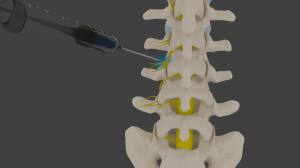For patients who are having pain caused by a compressed or damaged nerve, finding relief is paramount. One of the most common methods used to obtain pain relief is to administer a nerve block directly to the source of pain.
This block serves as numbing of the nerve group in order to prevent the transmission of  pain signals from that nerve to the brain. The block is a fairly short outpatient procedure with low risk that can provide great relief.
pain signals from that nerve to the brain. The block is a fairly short outpatient procedure with low risk that can provide great relief.
How the Injection is Performed
In many cases, there are no special preparation requirements prior to the injection. The patient will be placed prone on a table that x-rays can go through. These tables provide constant imaging for the workers comp pain doctor, allowing for the accurate placement of the needle within the nerve block. The skin of the injection site will be numbed with local anesthetic. In many cases, there is no need for IV sedation, but those patients who desire it may request it.
Once the needle has been properly guided into the nervous tissue, the anesthetic will be administered and typically a steroid will also be placed for longer lasting results. The patient will be monitored for 20 to 30 minutes following the injection to ensure there are no negative reactions. Pain relief should be felt immediately if the injection is successful.
Purpose of a Nerve Block
There are two purposes why a nerve block maybe performed for a patient: diagnostic and/or therapeutic.
 A diagnostic nerve block will use a smaller amount of numbing agent and is performed to see if the nerve in question is the actual cause of the pain. Once the block has been performed, and the pain symptoms fade, then the nerve is likely the root cause of pain. Once this has been established the Arizona workmans compensation doctor may perform a therapeutic block.
A diagnostic nerve block will use a smaller amount of numbing agent and is performed to see if the nerve in question is the actual cause of the pain. Once the block has been performed, and the pain symptoms fade, then the nerve is likely the root cause of pain. Once this has been established the Arizona workmans compensation doctor may perform a therapeutic block.
A therapeutic block is performed with the full dosage of the numbing agent, and is meant to provide the patient symptomatic relief for an extended period of time. It is common for a steroid to be injected along with the numbing agent, with the purpose of extending this relief duration.
Therapeutic blocks that prove successful may be repeated as needed to sustain pain relief. If subsequent blocks mimic the relief offered by the first, radiofrequency ablation may be suggested to the patient for even longer relief of pain.
Risks of a Block
This procedure has very minimal risks to it. There is a small chance of swelling, bleeding, or infection at the injection site. There is also a chance of an allergic reaction to the  injection agents, or a transient blood sugar increase or water retention due to the steroid.
injection agents, or a transient blood sugar increase or water retention due to the steroid.






Leave A Comment